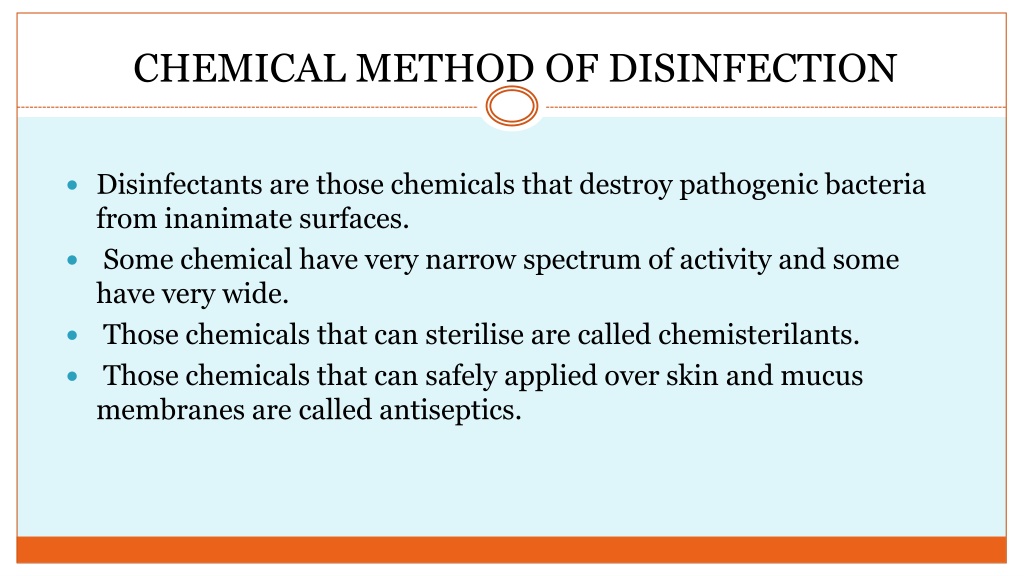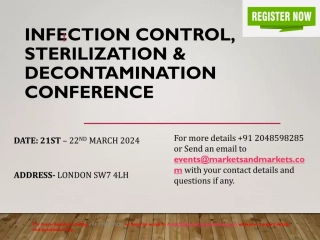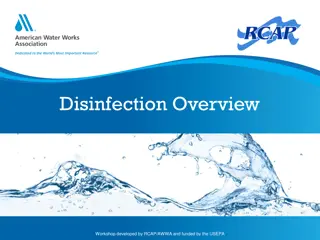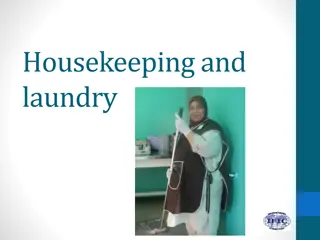Understanding Chemical Methods of Disinfection in Healthcare
Disinfectants play a crucial role in eliminating pathogenic bacteria from surfaces in healthcare settings. They come in various forms with different spectra of activity. This article delves into the classification of disinfectants, their spectrum of activity, properties required for chemical agents, and details about key disinfectants like alcohols and aldehydes. Learn about their effectiveness, uses, advantages, and disadvantages in ensuring a safe and sterile environment for patients and healthcare professionals.
Download Presentation

Please find below an Image/Link to download the presentation.
The content on the website is provided AS IS for your information and personal use only. It may not be sold, licensed, or shared on other websites without obtaining consent from the author. Download presentation by click this link. If you encounter any issues during the download, it is possible that the publisher has removed the file from their server.
E N D
Presentation Transcript
CHEMICAL METHOD OF DISINFECTION Disinfectants are those chemicals that destroy pathogenic bacteria from inanimate surfaces. Some chemical have very narrow spectrum of activity and some have very wide. Those chemicals that can sterilise are called chemisterilants. Those chemicals that can safely applied over skin and mucus membranes are called antiseptics.
Classification of disinfectants: 2.Chemical Liquid Alcohols Aldehydes Dyes Phenols Halogens Surface-active agents Metallic salts Gaseous Ethylene oxide Formaldehyde
Spectrum of activity Vegetativ e cells Mycobacter ia Spor es Fungi Viruse s Examples Ethylene oxide, Gluteraldehyde, Formaldehyde High level + + + + + Phenol, Halogens Intermediat e level + + - + + Alcohols Low level + - - + +/-
Properties required for chemical agents: Should have a wide spectrum of activity and be effective against all microorganisms. Should be effective in the presence of organic matter. Should be effective in acid as well as alkaline media. Should have speedy action. Should have penetrating power. Should be stable. Should not corrode metals. Should not cause local irritation or sensitisation. Should not interfere with healing. Should not toxic if absorbed into circulation.
Alcohols: Alcohols dehydrate cells, disrupt membranes and cause coagulation of protein. A 70% aqueous solution is more effective at killing microbes than absolute alcohols. 70% ethyl alcohol (spirit) is used as antiseptic on skin. Isopropyl alcohol is preferred to ethanol.It can also be used to disinfect surfaces. It is used to disinfect clinical thermometers. Methyl alcohol kills fungal spores, hence is useful in disinfecting inoculation hoods. Examples: Ethyl alcohol, isopropyl alcohol and methyl alcohol. Disadvantages: Skin irritant, volatile (evaporates rapidly), inflammable.
Aldehydes: Acts through alkylation of amino, carboxyl or hydroxyl group and probably damages nucleic acids. It kills all microorganisms including spores. 40% fomaldehyde or formalin is used for surface disinfection and fumigation of rooms, chambers, operation theatres, biological safety cabinets, wards, sick rooms etc. Fumigation is achieved by boiling formalin, heating paraformaldehyde or treating formalin with potassium permanganate. 2% gluteraldehyde is used to sterilise thermometers, cystoscopes, centrifuges, anasethetic equipments etc. Examples: Formaldehyde, Gluteraldehyde. Disadvantages: Vapors are irritating (must be neutralized by ammonia), has poor penetration.
Phenol: Act by disruption of membranes, precipitation of proteins and inactivation of enzymes. Phenols are coal tar derivatives, they act as disinfectants at high concentration and as antiseptics at low concentrations. They are bactericidal, fungicidal, mycobactericidal but are inactive against spores and most viruses. The corrosive phenolics are used for disinfection of ward floors, in discarding jars in laboratories and disinfection of bedpans. Chlorhexidine can be used in an isopropanol solution for skin disinfection, or as an aqueous solution for wound irrigation. Examples: 5% phenol,1-5% Cresol, 5% Lysol, Chlorhexidine, Chloroxylenol (Dettol), Hexachlorophene. Disadvantages: It is toxic, corrosive and skin irritant.
Halogens: They are oxidizing agents and cause damage by oxidation of essential sulfydryl groups of enzymes. Chlorine reacts with water to form hypochlorus acid, which is microbicidal. Tincture of iodine (2% iodine in 70% alcohol) is an antiseptic. Iodine can be combined with neutral carrier polymers such as polyvinylpyrrolidone to prepare iodophores such as povidone-iodine. 10% Povidone iodine is used undiluted in pre and post operative skin disinfection. 0.5% sodium hypochlorite is used in serology and virology. Used at a dillution of 1:10 in decontamination of spillage of infectious materials. Examples: Chlorine, bleach, hypochlorite, tincture iodine etc. Disadvantages: Rapidly inactivated in the presence of organic matter. Iodine is corrosive and staining.
Heavy metals: Act by precipitation of proteins and oxidation of sulfydryl groups. They are bacteriostatic. 1% silver nitrate solution can be applied on eyes as treatment for opthalmia neonatorum. Silver sulphadiazine is used topically to help to prevent colonization and infection of burn tissues. Copper salts are used as a fungicide. Examples: Mercuric chloride, silver nitrate, copper sulfate etc. Disadvantages: Mercuric chloride is highly toxic.
Surface active agents: They are active against vegetative cells, mycobacteria and enveloped viruses. They are widely used as disinfectants at dilution of 1-2% for domestic use and hospitals. They have the property of concentratig at interfaces between lipid containing membrane of bacterial cell and surrounding aqueous medium. These compounds have long chain hydrocarbons that are fat soluble and charged ions that are water soluble. Since they contain both of these, they concentrate on the surface of membranes. They disrupt membrane resulting in leakage of cell constituents. Examples: These are soaps and detergents. Disadvantages: Their activity is reduced by hard water, anionic detergents and organic matter.
Dyes: Acredine dyes are bactericidal because of their interaction with bacterial nucleic acids. They may be used topically as antiseptics to treat mild burns. They are used as paint on skin to treat bacterial skin infections. The dyes are used as selective agents in certain selective media. Examples:Aniline dyes such as crystal violet, malachite green and brillient green, acridine dyes etc.
Hydrogen peroxide : It acts on the microorganisms through its release of nascent oxygen. Hydrogen peroxide produces hydroxyl free radical that damages proteins and DNA. It is used 6% concentration to decontaminate the instruments, equipments such as ventilators. 3% hydrogen peroxide solution is used for skin disinfection and deodorising wounds and ulcers. Strong solutions are sporicidal. Disadvantage: Decomposes in light, broken down by catalase, proteinaceous organic matter drastically reduces its activity.
Ethylene oxide: It is an alkylating agent. It acts by alkylating sulfydryl, amino, carboxyl, and hydroxyl groups. It is a highly effective chemisterilent, capable of killing spores rapidly. Since it is highly flammable, it is usually combined with carbon di oxide (10% CO2 +90% EO) or dichlorodifluoromethane. It is used to sterilise heat labile articles such as bedding, textiles, rubber, plastics, syringes, disposable petri dishes, heart lung machine, respiratory and dental equipments. Disadvantages: It is highly toxic,irritating to eyes, skin, highly flammable, mutagenic and carcinogenic.
References Textbook of Medical Microbiology by Ananthnarayan and Paniker Textbook of Medical Microbiology by D.R. Arora























